
![]()
Dear fellow members and friends
19 February 2008
Sheila is in hospital with a fractured hip after a fall on the seafront at the Beacon Half-Marathon (she was going to play with 'Silver Sounds' – as it happens). We all hope she'll be out and about again soon.
Planning rides
Here as usual are the remaining dates for 2008: 16 (Leon), 30 March (Jim); 13, 27 April; 11, 25 May; 8, 22 June; 6, 20 July; 3, 17, 31 Aug; 14, 28 Sept; 12 Oct; 2, 16, 30 Nov; 14 Dec.
Badges and Books
I've now sold two of the silver trumpet Clarion badges (at £6) and one of Denis Pye's history of the Clarion CC – Fellowship is Life (£4.95) One or two people have mentioned that they might like one and/or the other before I send the remainder back to the National Treasurer in few week's time. If you are one, please let me know if you want to make that a definite order or confirm that you have already asked me (and I've forgotten!). The origins of the badge are revealed in my latest extract from the Clarion in 1894 which you will find at the end of this circular.
Jim's organised the next ride (details below). Thanks, Jim. And you'll see another one of his and one of Leon's scheduled in the 'Planning Rides' bit above. Any more volunteers?
The Next Ride
Sunday 2 March 2008
Lanes of East Surrey: Horley – Burstow – Outwood – South Nutfield – Horley
About 17 miles; mainly on-road, some off; only one serious hill.
The first few miles will be dogged by sporadic aircraft noise, and we also cross two motorways*. But these things don't seem to bother the local wildlife; I saw a heron and a fox on the practice ride, as well as several squirrels.
At Outwood Common we will make for the Dog & Duck – the other pub here, the Bell, is already fully booked for that day (it's Mother's Day – groan!).
After a third motorway crossing, and some stupendous views of the North Downs, we reach South Nutfield – the northernmost point on our route – and then pass the entrance to Redhill Aerodrome. There is a café here, perhaps not quite as grand as the one at Shoreham, but we could have a quick tea stop and watch the planes, or if we have not been able to get into the pub, we can have lunch here.
Much of the return leg is along National Cycle Route 21, whose signposts indicate, a trifle optimistically perhaps, that it goes to Greenwich! (One for the CTC boys, perhaps?)
Back at Horley, the station café will be open and so we can have a cuppa before catching the train if we want.
If you like this one, there are plenty more rides to be had in this area.
This is a very rare example of engineering works being beneficial, as the works are taking place from Horley onwards, so all trains have to stop there! (Normally you would have to change at Gatwick.)
10.00 train from Brighton to Horley (arriving 10.41); Return trains leave Horley at 08 mins. past the hour and arrive at Brighton at 50 minutes past.
* By bridges, silly!
The Last Ride - Anne's Report
Sunday 17 February
Crossing the border - 11 cyclists, 2 golden hinds, 1 black swan and hundreds of pigs.
Tessa and Ian were waiting on the platform at Chichester for the arrival of the Brighton train, from which appeared: Alice, Joyce, Fred, Suzanne, Roger and Leon, [all the way from Hassocks]. Mick and I, Anne, made 10 and we all trekked back to the car park to welcome Amanda, who had driven all the way from East London, with the help of her Satnav. It proved tricky to find a photographer from the public, so Fred did the honours himself and we set out, somewhat late, along the trail to the Centurion Way, the fine Sustrans track.
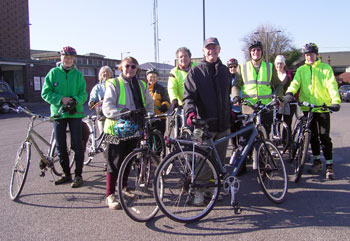
The start at Chichester (Fred behind the camera)
Amanda's Satnav was still commanding her from her backpack, to turn right or U-turn and head back to the station, but it eventually surrendered to the peaceful charms of the old railway path crossing the Roman Road, heading north. We were overtaken a few times by racers in streamlined kit, but mostly were able to relax and chat as we pedalled between the hedges and bushes, with fine views of West Sussex fields, hills, woods and trilling birds on a beautiful, sunny, crisp day. We had to pass by Sustrans volunteers trying to do surveys and press on and were amused at an elderly walker's attempt to herd us into single file, even though he, his wife and a trailing dog, didn't appear to be walking in an orderly line! The centurion sculptures were photographed with Amanda and Leon, as they hadn't seen them before. The iron-age fort was to our left, but we continued north, under the bridge decorated by mobiles of local fauna made by local schoolchildren.
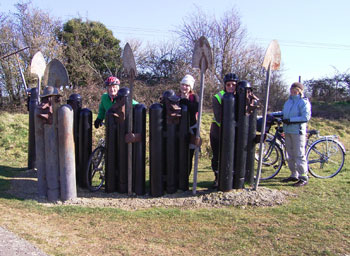
Centurian navvys
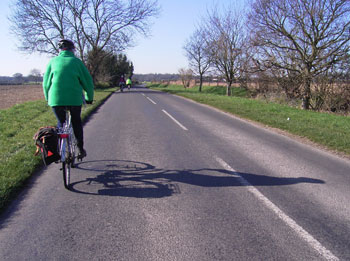
Tessa's shadow
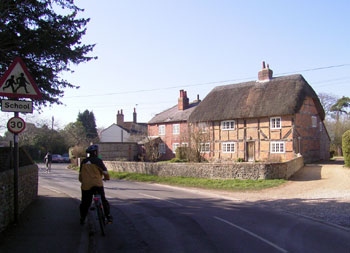
Suzanne admires the thatched cottage
Heading west from Lavant, Watery Lane led off from a roadside lake with ducks, geese and a black swan, perhaps more familiar to Amanda and Alice who come from the Antipodes. Roadsides were decorated with narrow brooks of clear water, some with watercress and some banks coated with cheery, yellow celandines. Some of us were hungry by then and regretted having to pass 4-star inns, such as The George and Dragon, but Ian rallied us on to the border, through West Stoke, East and West Ashling and Funtington.
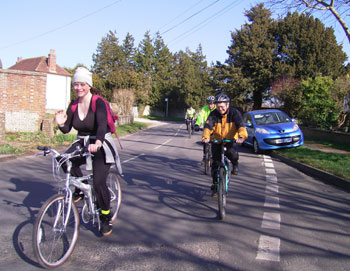
More shadows

Black swan
At a 'surprisingly remote' spot a sinister high-fenced, control-towered, guard-dog protected premises appeared. It was Qinetiq, the former MOD research centre, privatised since 2002 and sold at bargain price to venture capitalists who made a fortune out of it. Beyond them was a pig farm. Further along our road was another pig farm, much closer and full of hundreds of little piglets who scampered off in a stampede up their hill as we approached in our jolly convoy. Don't think we were going in a circle at that point but I've never seen so many delightful little piglets squealing and galloping along their fields and towards their little tin homes. Perhaps they felt the same about us.
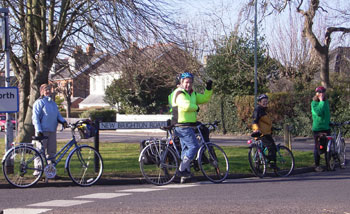
New Brighton Road
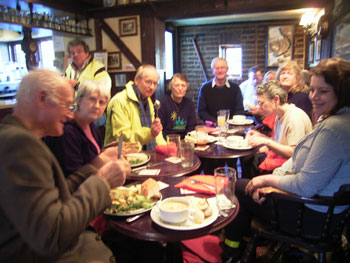
Inside the Stag's Head
We had to pass through Westbourne in order to cross the border and view the New Brighton Road sign. It wasn't until we returned to Westbourne and were welcomed to West Sussex by a low sign, that we appreciated that we had actually visited Hampshire, which still had not put up any welcome signs their side of the border, as Ian noted in 2005. Passing The White Horse, we saw they boasted Russian home-cooking on Monday to Fridays and Mick was tempted, but Ian turned out to be right in choosing The Stag's Head for us, even though we had to wait 20 minutes for the food. The four of us who chose soup were delighted by a Thai bean and giant prawn soup of most delicious, sustaining and unusual flavour. Eventually we were all served with our heart's desires and sat beneath the brass head of a young stag, below which fine horse brasses hung down. Hope there is a photo. [I think Leon took one - Fred]
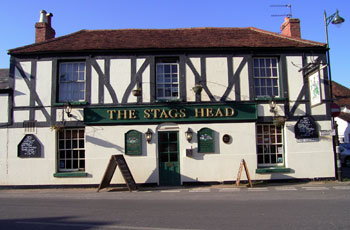
The Stags Head, Westbourne (no apostrophe!)
We didn't leave till 2.45pm and felt stiff on leaving the warm, cosy pub to venture out into the East wind, which we hadn't noticed propelling us westward. Bike computers telling us that we'd already done 13 miles, some calculate that the trip back should only be 7 miles, so Ian did do a bit of a short cut again. As we approached the backside of Qinetiq this time, on a quiet road parallel to the M27, Sussex Police cars scurried by us from both directions. Were they guarding defence secrets or protecting the border from Hampshire Police?
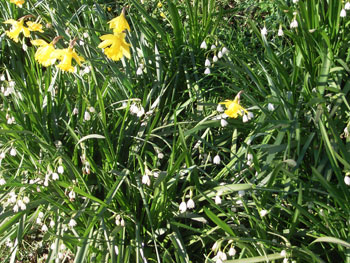
Daffodils and snowdrops
At the next crossroads Mick had noticed a dead fawn on the roadside grass. Many times I've seen road signs warning of deer, but you would never have noticed this poor animal in a speeding car. Only on a bike do you see the road kill toll. Only on a bike do you appreciate the curious road names: Lye Lane, Mouthey's Lane and Watery Lane all told an old story and Leon and Fred were eager to photograph them and immortalise our February adventure.
Thanks to Ian we all got safely back and had a glorious day, though Alice had a small fall right at the end while dismounting to cross the level-crossing at Chichester. Hope she isn't badly bruised. Also hope that Sheila is all right after her fall earlier in the day, on her way to Silver Sounds' performance at the Brighton half-marathon event.
Anne
--
The Origins of the Clarion Cycling Club - a national link-up is proposed
I reproduced the original letter about the Birmingham Clarion CC's Easter Tour in 1894 in the last Circular. It appeared at the end of April. Just a few weeks later on 26 May in a miscellany of local reports entitled 'Notes from the Front' the following piece appeared as part of a report from 'Manchester and District' by Leonard Hall.
The latest and greatest 'idea' in the world is that of a National 'Clarion' Cycling Club with local centres. The electrical Tom Grooms and the oak-hearted Harry Atkinsons of Birmingham have the honour of inspiration but there is nothing 'Brummagem' about it. These neighbours of Joseph the Pneumatic have already a lively little society of 'jiggers' who wear in their caps a natty gilt badge consisting of a miniature bugle with the legend 'Clarion' in silver letters – all permanent wear and who not only enjoy themselves but spread the gospel by way of sticking I.L.P. labels and texts wheresoever they wander on wheels. Besides which they can lend a hand – or rather a voice – at struggling branch meetings in adjacent districts wherever occasion calls
. . .
I.L.P. cyclists – and their name is now legion – all over the country can have the aforementioned emblems by applying to Comrade Chris Thompson, 253 Park Road, Hockley, Birmingham, who is the designer. And local societies that wish to fall in with the National 'C' C.C. should communicate with the same gentleman at once, as it is proposed to organise a great gathering of the clans later in the summer at some convenient centre – say Derbyshire.
. . .
By the way, why not have a great 'Clarion' picnic for all and sundry some August weekend, in some happy English valley, to which should come the faithful from the four corners of the world, on wheels, on legs, in trains, ye Bounder to preside over the revels and – er- the vittles.
Well, doesn't that last bit remind those present of our discussion at this year's (and last year's) AGM of the possibility of a summer picnic in, say, Stanmer Park? But I'm not so sure about 'all and sundry' and in the unavoidable absence of the Bounder we will have to make do with Ed. And of course the year following Hall's report the first Easter Meet took place at Ashbourne – in Derbyshire.
The badges that I am currently trying to get rid of (at £6) – and planning to return in a few weeks if not sold (or 'spoken for') - are reproductions of Chris Thompson's design. He, and Harry Atkinson and Tom Groom, appear in a contemporary photo of the original Birmingham club in Denis Pye's Fellowship is Life (£4.95). Chris Thompson seems to be one of two in the picture without a (visible) bike.
Anyone mystified by Hall's saying that 'there is nothing 'Brummagem' about it' should recall that at that time – and for many years before and after – Birmingham had the reputation of mass producing cheap and rubbishy goods, so his comment is meant as a compliment to the Clarion CC.
The writer of this piece, Leonard Hall, was a long-term ILP activist, probably best known later on, in 1910, as one of the authors of the 'Green Manifesto' (not an environmental tract, I'm afraid Joyce, but so called from the cover of the booklet). Its official name was Let Us Reform the Labour Party (yes, even then!). The story is told - I think I can allow myself a plug after all this hard work - in one of my chapters (the 'political' rather than 'union' ones) of Logie Barrow and Ian Bullock, Democratic Ideas and the British Labour Movement, 1880- 1914, Cambridge University Press, 1996, now available in affordable paperback from CUP!
Not to be confused with the Labour Party, that was to be founded as the Labour Representation Committee in 1900 the ILP, which (confusingly) affiliated to the Labour Party and became until after the First World War the main way in which individuals, as distinct from trade unions, participated in the Party, was of course the Independent Labour Party, founded at a conference in Bradford in January 1893 – the year before our present extract. The Clarion is credited with a major role in this. 'Independent' signified then independence from the Liberal Party. There were already a number of mostly miners' union leaders in the House of Commons representing the working class or 'Labour' interest as so-called 'Lib-Labs'
In March 1894, Keir Hardie launched his own weekly paper, Labour Leader, which was later to become the official organ of the ILP. The creation of this rival was rather resented by the Clarion which over the next two decades became something like the voice of the internal opposition to the Hardie/Labour Leader 'establishment' of the ILP and also the would-be spokesperson of the 'unattached' – socialists who declined to join either the ILP or its more radical rival the SDF (Social-Democratic Federation). Blatchford urged them to join both organisations and work for unity within them. Ignore, by the way, those histories of the period which see this simply in terms of a 'Marxist' SDF and a 'moderate' ILP. Perhaps the main distinguishing characteristic of the SDF was its support for more radical forms of democracy – proportional representation, the referendum and initiative, more frequent parliamentary elections, abolition of cabinet government, accountability of both the elected and the permanent official and so on – things that the Clarion tended to support but not Keir Hardie and Co in the ILP leadership.
Ian